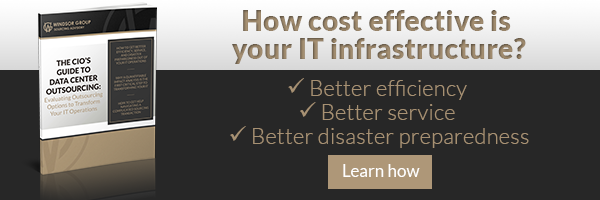
Seems like only yesterday that servers, storage area networks (SANs), and virtualization were the topics of discussion in IT; and now, fast forward a few years, hyperconvergence is taking center stage. Hyperconvergence, which simply didn’t exist five years ago, is growing in popularity among CIOs due to its ability to help modernize and streamline an enterprise’s IT strategy through a hyperconverged infrastructure. With the need to support growing business and market demands, all while reducing administrative costs and the storage footprint within an organization’s data center, it has become key to maintaining an efficient, flexible, and adaptable infrastructure environment.
Given that hyperconvergence is still somewhat of a new concept, it is worth discussing what exactly it is, the benefits it provides to IT organizations and CIOs alike, and how it is being implemented into today’s enterprises.
What is Hyperconvergence?
It can be described as an infrastructure system that employs a software-centric architecture that allows organizations to integrate compute, storage, networking, and virtualization resources into a commodity hardware box supported by a single vendor.
With the widely-felt need for IT organizations to optimize infrastructure functionality and productivity while reducing operational expenses, CIOs have been forced to reassess their existing infrastructure environments in an effort to adopt innovations that can provide the levels of scalability and agility necessary to support these demands. By expanding the use of software rather than hardware, IT organizations are now able to consolidate the physical components of their data center to deliver a single system that can run, manage, and maintain in-house applications through virtualized resources, while streamlining data protection and disaster preparedness.
Why Are So Many Organizations Employing a Hyperconverged Infrastructure?
There is a seemingly endless list of reasons why modern enterprises are employing a hyperconverged infrastructure environment, but among the most significant are its software-focus, use of commodity X86 hardware, centralized systems and management, and data protection.
- Software-Focused
As previously mentioned, a hyperconverged solution is very much software-driven, and thus, is able to provide substantially higher levels of flexibility and agility than that of a hardware-driven environment. Meaning, hyperconvergence allows organizations to meet current and future business needs without having to rip and replace existing infrastructure components every time a new demand surfaces. In addition, whenever software updates are released, organizations can realize the benefits immediately, rather than having to replace their hardware first.
- Use of Commodity X86 Hardware
Hyperconverged infrastructure environments are able to leverage commodity hardware, but while gaining the advantages of specialty hardware. Not only does this significantly reduce the costs associated with implemented specialty hardware, but it also provides the benefits of failure avoidance and high availability due to the agility hyperconvergence provides.
- Centralized Systems and Management
As discussed, hyperconvergence consolidates all components – compute, storage, networking, so on and so forth – into a single shared resource pool that enables organizations to manage aggregated resources across individual nodes as a single system. This centralization, regardless of where physical resources are located, offers the same tangibility as if those resources were in the same room.
- Data Protection
With traditional infrastructure environments, data protection can often be a very expensive and complex process to go through. On the contrary, with hyperconvergence, backup, recovery, and disaster recovery and already built in, so there is no need to seek out third-part integrations that are both cumbersome and costly.
How Are Modern Enterprises Implementing a Hyperconverged Infrastructure?
By now, you’ve likely realized the advantages that a hyperconverged solution can offer today’s enterprises, but you may be wondering how to go about implementing it; this is where IT management companies, like Windsor Group, come into play. IT management companies are great assets to leverage when it comes to the strategic assessment of your existing infrastructure, the evaluation of potential opportunities, and the selection of potential service providers.
With any major strategic decision, a considerable amount of evaluation and deliberation is required, but when a decision affects the supporting infrastructure of an entire business, it only increases. IT management companies are able to relieve some of the undoubted stress and frustration that goes along with a decision of this magnitude by applying their industry expertise and market insight to this process.
With business and market demands continuing to rise, and the need to reduce operational and administrative expenses increasing, hyperconvergence is gradually becoming the standard for what a cost-effective, efficient, and agile infrastructure looks like. Particularly for CIOs, the ability to adopt a solution that substantially reduces the amount of physical space needed to maintain its IT infrastructure, enhance management and maintenance capabilities, reduce operational costs by employing fewer resources in-house, and leverage a lower total cost of ownership (TCO) than traditional infrastructure environments, has enabled the implementation of modernized IT strategies that not only combat, but embrace, the ever-evolving challenges of the IT landscape.


